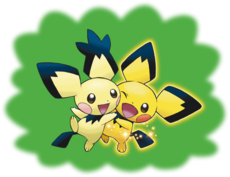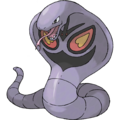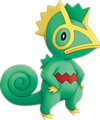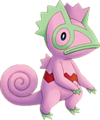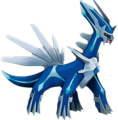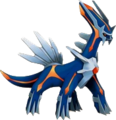Variant Pokémon: Difference between revisions
m (→Primal Dialga) |
mNo edit summary |
||
| (48 intermediate revisions by 21 users not shown) | |||
| Line 7: | Line 7: | ||
===Form differences=== | ===Form differences=== | ||
{{main|Form differences}} | {{main|Form differences}} | ||
Form differences are major variations that are officially | Form differences are major variations that are officially recognized by the Pokédex. | ||
===Shiny Pokémon=== | ===Shiny Pokémon=== | ||
| Line 15: | Line 15: | ||
===Shadow Pokémon=== | ===Shadow Pokémon=== | ||
{{main|Shadow Pokémon}} | {{main|Shadow Pokémon}} | ||
Shadow Pokémon are Pokémon that have had the door to their heart shut artificially by [[Cipher]]. They are the only Pokémon capable of using [[Shadow | Shadow Pokémon are Pokémon that have had the door to their heart shut artificially by [[Cipher]]. They are the only Pokémon capable of using [[Shadow move]]s. | ||
===Gender differences=== | ===Gender differences=== | ||
| Line 21: | Line 21: | ||
From [[Generation IV]] onward, there are many Pokémon that [[List of Pokémon with gender differences|appear differently]] as a result of their [[gender]]. | From [[Generation IV]] onward, there are many Pokémon that [[List of Pokémon with gender differences|appear differently]] as a result of their [[gender]]. | ||
Of these, {{p|Unfezant}}, {{p|Frillish}} and {{p| | Of these, {{p|Unfezant}}, {{p|Frillish}}, {{p|Jellicent}}, {{p|Pyroar}}, and {{p|Meowstic}} differ so drastically that they even have separate menu sprites and artworks. | ||
===Giant Pokémon=== | ===Giant Pokémon=== | ||
| Line 35: | Line 35: | ||
[[File:Mewtwo Clones.png|thumb|Mewtwo, Venusaurtwo, Blastoisetwo, Sandslash, Vaporeon, Golduck, Nidoqueen, Ninetales, Vulpix, Vileplume, Wigglytuff, Rapidash, Rhyhorn]] | [[File:Mewtwo Clones.png|thumb|Mewtwo, Venusaurtwo, Blastoisetwo, Sandslash, Vaporeon, Golduck, Nidoqueen, Ninetales, Vulpix, Vileplume, Wigglytuff, Rapidash, Rhyhorn]] | ||
{{main|Cloning}} | {{main|Cloning}} | ||
Cloned Pokémon are Pokémon that have been artificially duplicated from another specimen. This process both works on living and fossilized specimens. Many of these clones are not identical to their original specimen: {{ | Cloned Pokémon are Pokémon that have been artificially duplicated from another specimen. This process both works on living and fossilized specimens. Many of these clones are not identical to their original specimen: {{OBP|Mewtwo|original series}}, {{p|Bulbasaur}}two, {{p|Charmander}}two, {{p|Squirtle}}two, [[Pikachutwo]], {{p|Venusaur}}two, {{p|Charizard}}two, {{p|Blastoise}}two, and {{p|Meowth}}two all display this. | ||
Other known cloned Pokémon are {{p|Psyduck}}, {{p|Seadra}}, {{p|Tentacruel}}, {{p|Pidgeot}}, {{p|Scyther}}, {{p|Hitmonlee}}, {{p|Dewgong}}, {{p|Sandslash}}, {{p|Vaporeon}}, {{p|Golduck}}, {{p|Nidoqueen}}, {{p|Ninetales}}, {{p|Vulpix}}, {{p|Vileplume}}, {{p|Wigglytuff}}, {{p|Rapidash}}, and {{p|Rhyhorn}}. | Other known cloned Pokémon are {{p|Psyduck}}, {{p|Seadra}}, {{p|Tentacruel}}, {{p|Pidgeot}}, {{p|Scyther}}, {{p|Hitmonlee}}, {{p|Dewgong}}, {{p|Sandslash}}, {{p|Vaporeon}}, {{p|Golduck}}, {{p|Nidoqueen}}, {{p|Ninetales}}, {{p|Vulpix}}, {{p|Vileplume}}, {{p|Wigglytuff}}, {{p|Rapidash}}, and {{p|Rhyhorn}}. | ||
<center><gallery> | <center><gallery> | ||
File:Mewtwo | File:Mewtwo M01.png|Mewtwo | ||
File:Kanto Starter Clones.png|Bulbasaurtwo, Charmandertwo, Squirtletwo | File:Kanto Starter Clones.png|Bulbasaurtwo, Charmandertwo, Squirtletwo | ||
File:Pikachutwo.png|Pikachutwo | File:Pikachutwo.png|Pikachutwo | ||
| Line 80: | Line 80: | ||
<center><gallery> | <center><gallery> | ||
File:Pink Pokemon.png|Caterpie, Mankey, Venonat, Weedle, Primeape | File:Pink Pokemon.png|Caterpie, Mankey, Venonat, Weedle, Primeape | ||
File: | File:Pink Rhyhorn.png|Rhyhorn | ||
File:Pink Pokemon 2.png|Rhydon, Exeggutor, Bellsprout, Vileplume, Mankey, Primeape | File:Pink Pokemon 2.png|Rhydon, Exeggutor, Bellsprout, Vileplume, Mankey, Primeape | ||
File:Pink Diglett 2.png|Paras, Diglett | File:Pink Diglett 2.png|Paras, Diglett | ||
| Line 94: | Line 94: | ||
==Individual species== | ==Individual species== | ||
===Arbok=== | ===Arbok=== | ||
The [[Generation I]] {{DL|Arbok (Pokémon)|Pokédex entries}} for {{p|Arbok}} state that there are six variations of markings | The [[Generation I]] {{DL|Arbok (Pokémon)|Pokédex entries}} for {{p|Arbok}} state that there are six variations of its face-like hood markings that differ between areas. Eight designs are known, but only four have appeared in the games, and only three of which appeared in main series games. In [[Pokémon Adventures]], Arbok gains a special ability depending on its pattern. | ||
The most common | The most common hood pattern has red, teardrop-shaped eyes outlined in black with yellow, elongated hearts inside, a black mouth, and a black arrow over the eyes, with two red dots near the tip and an upward-extending tail. This design appeared in the Generation I games and all games from {{game|FireRed and LeafGreen|s}} on, the anime, the manga (except [[Agatha]]'s Arbok in Pokémon Adventures), most TCG art, the FireRed and LeafGreen [[Ken Sugimori]] art, Dream World art, and anime art. In the Pokémon Adventures manga, this is the "regenerative pattern" and is present on [[Koga]]'s Arbok. These Arbok have a forked tongue and many fangs. | ||
Arbok also has several variations with | Arbok also has several hood variations with round eyes and a red mouth outlined in black. The most common variation of this has two black fangs descending onto its mouth, black eyebrows, and outward-pointing eyelashes. This design first appeared in the official {{game|Red and Green|s}} Ken Sugimori artwork, and has also appeared in the {{3v2|Ruby|Sapphire|Emerald}} sprites, the TCG cards {{TCG ID|Fossil|Arbok|31}} from {{TCG|Fossil}}, {{TCG ID|Expedition|Arbok|3}} from {{TCG|Expedition}}, and {{TCG ID|VS|Janine's Arbok|62}} from the {{TCG|VS}} set. These Arbok have a pointed tongue and four fangs. | ||
Another variation with | Another hood variation with round eyes appeared in {{3v2|Gold|Silver|Crystal}}. This pattern has no fangs or eyebrows, and its eyelashes point upward. It has also appeared in [[Pokémon Pinball]] and on the Arbok {{TCG|Coin}} in [[Pokémon Card GB2: Here Comes Team GR!]]. These Arbok have a forked tongue and four fangs. | ||
The final | The final round-eye variation only appeared in {{ga|Pokémon Ranger}}. This design has no eyelashes or fangs. A Y-shaped mark branches over each eye and connects to the middle to the mouth. The branches each have smaller, Y-shaped ends, between each of which resides a small black dot. | ||
Arbok's conceptual art had three other designs, but these were only used in the [[Pokémon Adventures]] manga, in which [[Agatha]]'s Arbok | Arbok's conceptual art had three other hood designs, but these were only used in the [[Pokémon Adventures]] manga, in which [[Agatha]]'s Arbok can change its markings to alter its powers. These are the speed, attack, and invulnerability patterns. | ||
An evil-looking pattern was created by [[Mitsuhiro Arita]] solely for the {{Trading Card Game}}. Each red eye has a black mark in the center and flared outsides, and shares a combined yellow border. Its mouth represents a grin with eleven pointed, red teeth outlined in black. It is featured in the card {{TCG ID|Team Rocket|Dark Arbok|2}} from the {{TCG|Team Rocket}} set. | |||
<center><gallery perrow=4> | <center><gallery perrow=4> | ||
| Line 123: | Line 123: | ||
Almost every Pokémon medium has featured a different Pikachu variant, most notably Surfing and Flying Pikachu. | Almost every Pokémon medium has featured a different Pikachu variant, most notably Surfing and Flying Pikachu. | ||
===Vulpix=== | |||
Several of {{p|Vulpix}}'s Pokédex entries mention that the species only has one, white-colored tail when they are born. The tail would then split into six orange-colored tails as it matures, and eventually splits from their tips to increase in number even more. | |||
{{OBP|Enta|CBF}}'s {{TP|Enta|Vulpix}} only has one tail in its debut in ''[[CBF1|Enta Arrives at the Battle Frontier!]]''. In the same chapter, its tails split into six. | |||
<center><gallery> | |||
File:Enta Vulpix one tail CBF.png|A one-tailed Vulpix in [[Pokémon Battle Frontier]] | |||
</gallery></center> | |||
===Shellder=== | ===Shellder=== | ||
{{p|Shellder}} can be either a bivalve shell or a spiral-shaped shell, depending on whether or not it is attached to a {{p|Slowpoke}}. Though impossible in the games, multiple Pokédex entries state that a Shellder can be detached from the {{p|Slowbro}} (making it [[Devolution|devolve]] into a Slowpoke) or {{p|Slowking}} (making it lose its memory) it is attached to. This gives them a few more characteristics of Shellder variants than actual evolutions. However, because the Shellder is attached to and evolves with the Slowpoke, after evolution they are treated as one Pokémon. Slowbro's conceptual art depicted other variations, but they were never seen anywhere else. | {{p|Shellder}} can be either a bivalve shell or a spiral-shaped shell, depending on whether or not it is attached to a {{p|Slowpoke}}. Though impossible in the games, multiple Pokédex entries state that a Shellder can be detached from the {{p|Slowbro}} (making it [[Devolution|devolve]] into a Slowpoke) or {{p|Slowking}} (making it lose its memory) it is attached to. This gives them a few more characteristics of Shellder variants than actual evolutions. However, because the Shellder is attached to and evolves with the Slowpoke, after evolution they are treated as one Pokémon. Slowbro's conceptual art depicted other variations, but they were never seen anywhere else. | ||
| Line 142: | Line 150: | ||
===Kangaskhan=== | ===Kangaskhan=== | ||
{{p|Kangaskhan}}'s | {{p|Kangaskhan}}'s {{pkmn|category}} in Japanese is "Parent and Child Pokémon", implying it consists of two beings. This is ratified by the fact that they are all [[Pokémon breeding#Hatching Eggs|born]] with a child in their pouch. The child is purple, and has not yet developed most of the features from its parent, having to stay in the pouch for 3 years. Although Kangaskhan's [[move]]s are performed by the parent, some {{Trading Card Game}} cards ([[Kangaskhan (Jungle 5)|Jungle Kangaskhan]], [[Blaine's Kangaskhan (Gym Heroes 36)|Blaine's Kangaskhan]], [[Kangaskhan (Aquapolis 88)|Aquapolis Kangaskhan]], and [[Kangaskhan (EX FireRed & LeafGreen 6)|EX FireRed & LeafGreen Kangaskhan]]) have attacks that involve or are performed by the child. | ||
When Kangaskhan [[Mega Evolution|Mega Evolves]] into Mega Kangaskhan, the baby emerges from the mother's pouch and is noticeably matured. | |||
<center><gallery> | <center><gallery> | ||
File:Parent Kangaskhan.png|Parent Kangaskhan | File:Parent Kangaskhan.png|Parent Kangaskhan | ||
File:GoodBabyKanga.png|Child Kangaskhan | File:GoodBabyKanga.png|Child Kangaskhan | ||
File:115Kangaskhan-Mega.png|Mega Kangaskhan | |||
</gallery></center> | </gallery></center> | ||
===Ditto=== | ===Ditto=== | ||
{{p|Ditto}} is known for its ability to {{m|transform}} into an exact replica of any other Pokémon. However, some Ditto are incapable of changing the face, with the result being a deformed copy of the target Pokémon with a blank, beady-eyed expression. | {{p|Ditto}} is known for its ability to {{m|transform}} into an exact replica of any other Pokémon. However, some Ditto are incapable of changing the face by memory, with the result being a deformed copy of the target Pokémon with a blank, beady-eyed expression. | ||
This appearance was first present in one of [[Duplica's Ditto]], both in the anime and in [[the Electric Tale of Pikachu]] manga. It was later seen in {{TCG|Ditto}} cards from the [[EX Delta Species]] expansion of the {{Trading Card Game}}, in a kind of {{p|Clefairy}} that appears in the [[Veilstone Game Corner]], and in the [[Special Episode]] ''[[Here Comes Team Charm!]]''. | This appearance was first present in one of [[Duplica's Ditto]], both in the anime and in [[the Electric Tale of Pikachu]] manga. It was later seen in {{TCG|Ditto}} cards from the [[EX Delta Species]] expansion of the {{Trading Card Game}}, in a kind of {{p|Clefairy}} that appears in the [[Veilstone Game Corner]], in ''[[Pokémon Snap]]'' with three Ditto disguised as {{p|Bulbasaur}}, and in the [[Special Episode]] ''[[Here Comes Team Charm!]]''. | ||
<center><gallery> | <center><gallery> | ||
| Line 189: | Line 200: | ||
===Spinda=== | ===Spinda=== | ||
Like Unown, {{p|Spinda}} has many visual variations in its species, all involving the placement of its spots. Like Unown's letter, the spot placement is generated based on the individual's [[personality value]], and likewise, has no effect on the Pokémon's stats. Unlike Unown, however, these differences are rarely repeated, as the calculation uses the entirety of the personality value—a number that can [[Personality value#Spinda's spots|range]] from [[Spinda (Pokémon)#Trivia|zero to 4,294,967,295]] (2<sup>32</sup> - 1). | Like Unown, {{p|Spinda}} has many visual variations in its species, all involving the placement of its spots. Like Unown's letter, the spot placement is generated based on the individual's [[personality value]], and likewise, has no effect on the Pokémon's stats. Unlike Unown, however, these differences are rarely repeated, as the calculation uses the entirety of the personality value—a number that can [[Personality value#Spinda's spots|range]] from [[Spinda (Pokémon)#Trivia|zero to 4,294,967,295]] (2<sup>32</sup> - 1). Some personality values can, however, produce the same apparent pattern from differing values. | ||
<center><gallery> | <center><gallery> | ||
| Line 199: | Line 210: | ||
A purple Kecleon is one of the two Kecleon Brothers in the [[Pokémon Mystery Dungeon]] series. He also appeared in the special episodes ''[[SS019|Pokémon Mystery Dungeon: Team Go-Getters out of the Gate!]]'' and ''[[SS020|Pokémon Mystery Dungeon: Explorers of Time & Darkness]]''. | A purple Kecleon is one of the two Kecleon Brothers in the [[Pokémon Mystery Dungeon]] series. He also appeared in the special episodes ''[[SS019|Pokémon Mystery Dungeon: Team Go-Getters out of the Gate!]]'' and ''[[SS020|Pokémon Mystery Dungeon: Explorers of Time & Darkness]]''. | ||
In ''[[EP205|The Kecleon Caper]]'', a purple {{p|Kecleon}} nicknamed Reddy appeared under the ownership of [[Madison]]. | In ''[[EP205|The Kecleon Caper]]'', a purple {{p|Kecleon}} nicknamed Reddy appeared under the ownership of [[Madison and Alexa|Madison]]. | ||
<center><gallery> | <center><gallery> | ||
| Line 205: | Line 216: | ||
File:Purple Kecleon PMD.png|Purple Kecleon | File:Purple Kecleon PMD.png|Purple Kecleon | ||
</gallery></center> | </gallery></center> | ||
===Unseen variants=== | ===Unseen variants=== | ||
Some variants have only been mentioned in Pokédex entries; Pokémon of these variants have not been shown in any Pokémon media. | Some variants have only been mentioned in Pokédex entries; Pokémon of these variants have not been shown in any Pokémon media. | ||
* The {{3v2|Diamond|Pearl|Platinum}} Pokédex entries for {{p|Weezing}} state that triplets of the species have been discovered. All Weezing have a third gas chamber, though it has no face. | |||
* The {{3v2|Diamond|Pearl|Platinum}} Pokédex entries for {{p|Weezing}} state that triplets have been discovered. | * {{p|Mantyke}}'s Pokédex entry in {{game|Diamond and Pearl|s|Pearl}} says that the pattern on its back varies from region to region. While there is no difference between the [[Sinnoh]] and [[Johto]] games (due to using the same sprites), the "face" in the [[Unova]] and [[Kalos]] games appears wider. However, all Mantyke within a Generation V or VI game will look the same, regardless of origin. | ||
* {{p|Mantyke}}'s Pokédex entry in {{game|Diamond and Pearl|s|Pearl}} says that the | |||
==Individual Pokémon== | ==Individual Pokémon== | ||
===Pink Butterfree=== | ===Pink Butterfree=== | ||
{{main|Pink Butterfree}} | {{main|Pink Butterfree}} | ||
A pink {{p|Butterfree}} appeared in ''[[EP021|Bye-Bye Butterfree]]'' | A pink {{p|Butterfree}} appeared in ''[[EP021|Bye-Bye Butterfree]]'' and paired up with [[Ash's Butterfree]], who then left {{Ash|his Trainer}} to go with her. | ||
<center><gallery> | <center><gallery> | ||
File:Pink Butterfree.png| | File:Ash Butterfree.png|Ash's Butterfree | ||
File:Pink Butterfree.png|Pink Butterfree | |||
</gallery></center> | </gallery></center> | ||
| Line 272: | Line 238: | ||
<center><gallery> | <center><gallery> | ||
File: | File:Brock Onix.png|Onix | ||
File:Crystal Onix.png|Crystal Onix | File:Crystal Onix.png|Crystal Onix | ||
</gallery></center> | </gallery></center> | ||
| Line 286: | Line 252: | ||
===Shadow Lugia=== | ===Shadow Lugia=== | ||
{{main|Shadow Lugia}} | {{main|Shadow Lugia}} | ||
XD001 was a | XD001 was a {{p|Lugia}} that was so thoroughly corrupted that its appearance changed. | ||
<center><gallery> | <center><gallery> | ||
| Line 295: | Line 261: | ||
===Fake Groudon=== | ===Fake Groudon=== | ||
{{main|Groudon (M06)}} | {{main|Groudon (M06)}} | ||
In ''[[M06|Jirachi: Wish Maker]]'', [[Butler]] created a | In ''[[M06|Jirachi: Wish Maker]]'', [[Butler]] created a mindless, evil {{p|Groudon}} using the power of his machine and {{p|Jirachi}}. This fake Groudon began to absorb all life in [[Forina]] until it was defeated by Jirachi. | ||
<center><gallery> | <center><gallery> | ||
File: | File:AG097.png|Groudon | ||
File:Fake Groudon.png|Fake Groudon | File:Fake Groudon.png|Fake Groudon | ||
</gallery></center> | </gallery></center> | ||
| Line 326: | Line 292: | ||
<center><gallery> | <center><gallery> | ||
File:Ash Bulbasaur illusion Venusaur.png|Gastly's illusory Venusaur | File:Ash Bulbasaur illusion Venusaur.png|Gastly's illusory Venusaur | ||
File:Ash Squirtle illusion Blastoise.png|Gastly's illusory Blastoise | File:Ash Squirtle illusion Blastoise.png|Gastly's illusory Blastoise | ||
File:Venustoise.png|Venustoise | |||
</gallery></center> | </gallery></center> | ||
===Thu-Fi-Zer=== | ===Thu-Fi-Zer=== | ||
{{main|Thu-Fi-Zer}} | {{main|Thu-Fi-Zer}} | ||
A combination of {{p|Articuno}}, {{p|Zapdos}} and {{p|Moltres}} made by [[Team Rocket]] in the [[Pokémon Adventures]] manga. The [[legendary birds]] were later freed. | A combination of {{p|Articuno}}, {{p|Zapdos}}, and {{p|Moltres}} made by [[Team Rocket]] in the [[Pokémon Adventures]] manga. The [[legendary birds]] were later freed. | ||
<center><gallery> | <center><gallery> | ||
File: | File:Koga Articuno Adventures.png|Articuno | ||
File:Lt Surge Zapdos Adventures.png|Zapdos | File:Lt Surge Zapdos Adventures.png|Zapdos | ||
File:Sabrina Moltres Adventures.png|Moltres | File:Sabrina Moltres Adventures.png|Moltres | ||
File: | File:Thu-Fi-Zer.png|Thu-Fi-Zer | ||
</gallery></center> | </gallery></center> | ||
| Line 346: | Line 312: | ||
<center><gallery> | <center><gallery> | ||
File:Mismagius anime.png|Mismagius | File:Mismagius anime.png|Mismagius | ||
File:Rayquaza M07.png|Rayquaza | File:Rayquaza M07.png|Rayquaza | ||
File:Magquaza.png|Mismagius and Rayquaza fusion | |||
</gallery></center> | </gallery></center> | ||
===Tao trio=== | ===Tao trio=== | ||
{{p|Reshiram}} and {{p|Zekrom}} | {{main|Form differences#Kyurem|Form differences → Kyurem}} | ||
Using the {{DL|List of key items in Generation V|DNA Splicers}}, {{p|Kyurem}} has the ability to be fused with {{p|Reshiram}} and {{p|Zekrom}}. | |||
{{ | {| class="roundy" align="center" style="background: #FFFFFF;" width="225px" | ||
|- align="center" | |||
| class="roundy" width="25%" style="background: #BCE6E6;" | Kyurem<br>[[File:646Kyurem.png|100px]]<br><small>{{typecolor|Dragon}}{{typecolor|Ice}}</small> | |||
| class="roundy" width="25%" style="background: #F5AC78;" | White Kyurem<br>[[File:646Kyurem-White.png|100px]]<br><small>{{typecolor|Dragon}}{{typecolor|Ice}}</small> | |||
| class="roundy" width="25%" style="background: #FAE078;" | Black Kyurem<br>[[File:646Kyurem-Black.png|100px]]<br><small>{{typecolor|Dragon}}{{typecolor|Ice}}</small> | |||
|} | |||
==See also== | |||
* [[List of Pokémon with gender differences]] | |||
* [[Form differences]] | |||
* [[Mega Evolution]] | |||
* [[Primal Reversion]] | |||
[[Category:Game mechanics]] | |||
[[Category:Pokémon world]] | |||
[[Category:Variant Pokémon|*]] | [[Category:Variant Pokémon|*]] | ||
[[Category:Pokémon world]] | [[Category:Pokémon world]] | ||
Revision as of 18:17, 17 July 2015
Variant Pokémon are Pokémon who vary in their appearance compared to other Pokémon of the same species. This is often due to gender, special traits and Abilities, diet or environmental factors such as climate. Certain symbiotic relationships may also play a role in this.
While many variances are caused by natural processes, they sometimes can be artificially invoked as well. This may be achieved through the use of physical modifications or behavioral conditioning, or contact with certain items and radiation.
Multiple species
Form differences
- Main article: Form differences
Form differences are major variations that are officially recognized by the Pokédex.
Shiny Pokémon
- Main article: Shiny Pokémon
Shiny Pokémon are rare alternate coloration of Pokémon. These Pokémon all have a shining animation at the beginning of the battle when they are sent out, or encountered.
Shadow Pokémon
- Main article: Shadow Pokémon
Shadow Pokémon are Pokémon that have had the door to their heart shut artificially by Cipher. They are the only Pokémon capable of using Shadow moves.
Gender differences
- Main article: List of Pokémon with gender differences
From Generation IV onward, there are many Pokémon that appear differently as a result of their gender.
Of these, Unfezant, Frillish, Jellicent, Pyroar, and Meowstic differ so drastically that they even have separate menu sprites and artworks.
Giant Pokémon
- Main article: Giant Pokémon
Giant Pokémon are Pokémon that are much larger than usual.
Ancient giant Pokémon
Several ancient giant Pokémon appeared in the The Ancient Puzzle of Pokémopolis. They were Gengar, Alakazam, and Jigglypuff. These Pokémon were all covered in tattoo-like marks.
Gengar emerged from a black dumbbell-like artifact, Alakazam emerged from a spoon-like artifact, and Jigglypuff emerged from an ancient bell.
Cloned Pokémon
- Main article: Cloning
Cloned Pokémon are Pokémon that have been artificially duplicated from another specimen. This process both works on living and fossilized specimens. Many of these clones are not identical to their original specimen: Mewtwo, Bulbasaurtwo, Charmandertwo, Squirtletwo, Pikachutwo, Venusaurtwo, Charizardtwo, Blastoisetwo, and Meowthtwo all display this.
Other known cloned Pokémon are Psyduck, Seadra, Tentacruel, Pidgeot, Scyther, Hitmonlee, Dewgong, Sandslash, Vaporeon, Golduck, Nidoqueen, Ninetales, Vulpix, Vileplume, Wigglytuff, Rapidash, and Rhyhorn.
Mirage Pokémon
- Main article: Mirage Pokémon
Mirage Pokémon are holographic Pokémon created by Dr. Yung. They have only appeared in The Mastermind of Mirage Pokémon.
Toy Pokémon
- Main article: Toy Pokémon
Toy Pokémon are Pokémon toys given self-awareness by Wonder Keys that appear in the Pokémon Rumble series. They are different to normal Pokémon in many ways; for example, they can only know two moves at a time.
Rusty Pokémon
- Main article: Rusty Pokémon
Over time Toy Pokémon rust, causing them to become Rusty Pokémon. Dark Rust can instantaneously rust Toy Pokémon. Rusty Pokémon can be restored using Glowdrops.
Valencian Pokémon
In the episode Poké Ball Peril, a number of alternately colored Pokémon were seen on Valencia Island, including Butterfree, Raticate, Nidoran♂, Nidoran♀, Vileplume, Paras, and Weepinbell.
Pink Pokémon
In the episode In The Pink, all of the Pokémon native to Pinkan Island were shown to be colored pink, due to their diet of Pinkan Berries. Pink Pokémon seen on the island include Caterpie, Weedle, Pidgey, Rattata, Pikachu, Nidoran♀, Nidoran♂, Nidoking, Vileplume, Paras, Parasect, Venonat, Diglett, Mankey, Primeape, Bellsprout, Dodrio, Exeggutor, Rhyhorn and Rhydon.
Further pink Pokémon seen during Team Rocket's fantasy include Pidgeotto, Arbok, Oddish, Poliwhirl, Geodude, Weezing, Scyther and Electabuzz.
Individual species
Arbok
The Generation I Pokédex entries for Arbok state that there are six variations of its face-like hood markings that differ between areas. Eight designs are known, but only four have appeared in the games, and only three of which appeared in main series games. In Pokémon Adventures, Arbok gains a special ability depending on its pattern.
The most common hood pattern has red, teardrop-shaped eyes outlined in black with yellow, elongated hearts inside, a black mouth, and a black arrow over the eyes, with two red dots near the tip and an upward-extending tail. This design appeared in the Generation I games and all games from Pokémon FireRed and LeafGreen on, the anime, the manga (except Agatha's Arbok in Pokémon Adventures), most TCG art, the FireRed and LeafGreen Ken Sugimori art, Dream World art, and anime art. In the Pokémon Adventures manga, this is the "regenerative pattern" and is present on Koga's Arbok. These Arbok have a forked tongue and many fangs.
Arbok also has several hood variations with round eyes and a red mouth outlined in black. The most common variation of this has two black fangs descending onto its mouth, black eyebrows, and outward-pointing eyelashes. This design first appeared in the official Pokémon Red and Green Ken Sugimori artwork, and has also appeared in the Ruby, Sapphire, and Emerald sprites, the TCG cards Arbok from Fossil, Arbok from Expedition, and Janine's Arbok from the VS set. These Arbok have a pointed tongue and four fangs.
Another hood variation with round eyes appeared in Gold, Silver, and Crystal. This pattern has no fangs or eyebrows, and its eyelashes point upward. It has also appeared in Pokémon Pinball and on the Arbok Coin in Pokémon Card GB2: Here Comes Team GR!. These Arbok have a forked tongue and four fangs.
The final round-eye variation only appeared in Pokémon Ranger. This design has no eyelashes or fangs. A Y-shaped mark branches over each eye and connects to the middle to the mouth. The branches each have smaller, Y-shaped ends, between each of which resides a small black dot.
Arbok's conceptual art had three other hood designs, but these were only used in the Pokémon Adventures manga, in which Agatha's Arbok can change its markings to alter its powers. These are the speed, attack, and invulnerability patterns.
An evil-looking pattern was created by Mitsuhiro Arita solely for the TCG. Each red eye has a black mark in the center and flared outsides, and shares a combined yellow border. Its mouth represents a grin with eleven pointed, red teeth outlined in black. It is featured in the card Dark Arbok from the Team Rocket set.
- Spr 2c 024.gif
Secondary circular pattern
Pikachu
- Main article: Pikachu variants
Almost every Pokémon medium has featured a different Pikachu variant, most notably Surfing and Flying Pikachu.
Vulpix
Several of Vulpix's Pokédex entries mention that the species only has one, white-colored tail when they are born. The tail would then split into six orange-colored tails as it matures, and eventually splits from their tips to increase in number even more.
Enta's Vulpix only has one tail in its debut in Enta Arrives at the Battle Frontier!. In the same chapter, its tails split into six.
A one-tailed Vulpix in Pokémon Battle Frontier
Shellder
Shellder can be either a bivalve shell or a spiral-shaped shell, depending on whether or not it is attached to a Slowpoke. Though impossible in the games, multiple Pokédex entries state that a Shellder can be detached from the Slowbro (making it devolve into a Slowpoke) or Slowking (making it lose its memory) it is attached to. This gives them a few more characteristics of Shellder variants than actual evolutions. However, because the Shellder is attached to and evolves with the Slowpoke, after evolution they are treated as one Pokémon. Slowbro's conceptual art depicted other variations, but they were never seen anywhere else.
Exeggcute and Exeggutor
Exeggcute are not always seen as a group of six; the number of heads an Exeggutor also varies. Exeggutor's Pokédex entries state that, living in a good environment, more heads will grow in addition to the three it is usually seen with. Eventually, one of the heads will fall off and become a sole Exeggcute. This Exeggcute will telepathically communicate with others, in order to join and form a cluster of six. Until they are gathered, Exeggcute won't be able to maintain balance.
Kangaskhan
Kangaskhan's category in Japanese is "Parent and Child Pokémon", implying it consists of two beings. This is ratified by the fact that they are all born with a child in their pouch. The child is purple, and has not yet developed most of the features from its parent, having to stay in the pouch for 3 years. Although Kangaskhan's moves are performed by the parent, some TCG cards (Jungle Kangaskhan, Blaine's Kangaskhan, Aquapolis Kangaskhan, and EX FireRed & LeafGreen Kangaskhan) have attacks that involve or are performed by the child.
When Kangaskhan Mega Evolves into Mega Kangaskhan, the baby emerges from the mother's pouch and is noticeably matured.
Ditto
Ditto is known for its ability to transform into an exact replica of any other Pokémon. However, some Ditto are incapable of changing the face by memory, with the result being a deformed copy of the target Pokémon with a blank, beady-eyed expression.
This appearance was first present in one of Duplica's Ditto, both in the anime and in the Electric Tale of Pikachu manga. It was later seen in Ditto cards from the EX Delta Species expansion of the TCG, in a kind of Clefairy that appears in the Veilstone Game Corner, in Pokémon Snap with three Ditto disguised as Bulbasaur, and in the Special Episode Here Comes Team Charm!.
- Ditto Sentret.png
Sentret
- Ditto Bellossom.png
Bellossom
Porygon
Porygon is able to change its color, shape and type to match its target with Conversion. It is also capable of changing its shape by using Sharpen.
Snorlax
In Snorlax Snowman, several ice-blue Snorlax adapted to more frigid climates appeared.
Spinda
Like Unown, Spinda has many visual variations in its species, all involving the placement of its spots. Like Unown's letter, the spot placement is generated based on the individual's personality value, and likewise, has no effect on the Pokémon's stats. Unlike Unown, however, these differences are rarely repeated, as the calculation uses the entirety of the personality value—a number that can range from zero to 4,294,967,295 (232 - 1). Some personality values can, however, produce the same apparent pattern from differing values.
Kecleon
A purple Kecleon is one of the two Kecleon Brothers in the Pokémon Mystery Dungeon series. He also appeared in the special episodes Pokémon Mystery Dungeon: Team Go-Getters out of the Gate! and Pokémon Mystery Dungeon: Explorers of Time & Darkness.
In The Kecleon Caper, a purple Kecleon nicknamed Reddy appeared under the ownership of Madison.
Unseen variants
Some variants have only been mentioned in Pokédex entries; Pokémon of these variants have not been shown in any Pokémon media.
- The Diamond, Pearl, and Platinum Pokédex entries for Weezing state that triplets of the species have been discovered. All Weezing have a third gas chamber, though it has no face.
- Mantyke's Pokédex entry in Pearl says that the pattern on its back varies from region to region. While there is no difference between the Sinnoh and Johto games (due to using the same sprites), the "face" in the Unova and Kalos games appears wider. However, all Mantyke within a Generation V or VI game will look the same, regardless of origin.
Individual Pokémon
Pink Butterfree
- Main article: Pink Butterfree
A pink Butterfree appeared in Bye-Bye Butterfree and paired up with Ash's Butterfree, who then left his Trainer to go with her.
Crystal Onix
- Main article: Crystal Onix
Crystal Onix is a special individual Onix that lives on Sunburst Island. Its body is made out of glass crystal. Due to being made out of crystal, it is no longer weak to Water-type attacks and instead weak to Fire-type attacks.
Gold Sudowoodo
In All That Glitters is Not Golden!, a Trainer named Keenan owned a Sudowoodo that he had turned to gold during a science experiment, in an attempt to make Sudowoodo immune to Water-type attacks. The changes made to Sudowoodo were eventually reversed.
Shadow Lugia
- Main article: Shadow Lugia
XD001 was a Lugia that was so thoroughly corrupted that its appearance changed.
Fake Groudon
- Main article: Groudon (M06)
In Jirachi: Wish Maker, Butler created a mindless, evil Groudon using the power of his machine and Jirachi. This fake Groudon began to absorb all life in Forina until it was defeated by Jirachi.
Green-crystal Deoxys
- Main article: Deoxys (M07)
One of the Deoxys that appeared in Destiny Deoxys had a green crystal instead of a purple one. It also had a green mark on its face instead of a purple one.
Primal Dialga
- Main article: Primal Dialga
In Pokémon Mystery Dungeon: Explorers of Time, Explorers of Darkness, and Explorers of Sky, Dialga became Primal Dialga when it lost control of time due to the collapse of the Temporal Tower. Dialga can regain control of time and revert to its normal self if all the Time Gears are brought to the tower. As Primal Dialga, it is incapable of logical reasoning or showing mercy, only seeking self-preservation and preventing time from flowing properly.
Combined Pokémon
Venustoise
In The Ghost of Maiden's Peak, a Gastly, who had the ability to create illusions that were tangible enough to attack people, created a fusion of Venusaur and Blastoise to scare Bulbasaur and Squirtle, calling it a "Venustoise" (Japanese: フシギックス Fushigix).
Thu-Fi-Zer
- Main article: Thu-Fi-Zer
A combination of Articuno, Zapdos, and Moltres made by Team Rocket in the Pokémon Adventures manga. The legendary birds were later freed.
Mismagius and Rayquaza
In Malice in Wonderland!, a real Mismagius merged with a Rayquaza illusion it created, giving Rayquaza the color palette and some features of Mismagius. It then attacked Ash and his friends.
- Magquaza.png
Mismagius and Rayquaza fusion
Tao trio
- Main article: Form differences → Kyurem
Using the DNA Splicers, Kyurem has the ability to be fused with Reshiram and Zekrom.
Kyurem Dragon Ice |
White Kyurem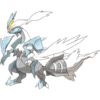 Dragon Ice |
Black Kyurem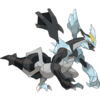 Dragon Ice |
